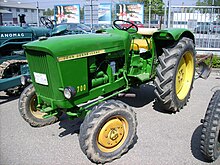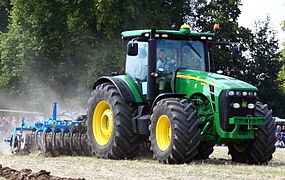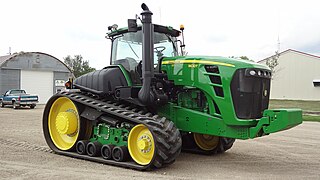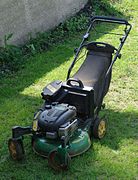John Deere
This article has multiple issues. Please help improve it or discuss these issues on the talk page. (Learn how and when to remove these messages)
|
 | |
 John Deere World Headquarters in Moline, Illinois | |
| Company type | Public |
|---|---|
| NYSE: DE S&P 500 Component | |
| Industry | Heavy equipment |
| Founded | Grand Detour, Illinois (1837)[1] |
| Founder | John Deere |
| Headquarters | , |
Area served | Worldwide |
Key people | Sam Allen (CEO and President) |
| Products | Agriculture, Construction, Forestry, Consumer & Commercial equipment, Diesel engines |
| Services | Financial services |
| Revenue | |
| Total assets | |
| Total equity | |
Number of employees | 67,000 (2013)[2] |
| Website | www |
Deere & Company (brand name John Deere), is an American corporation that manufactures agricultural, construction, and forestry machinery, diesel engines, drivetrains (axles, transmissions, gearboxes) used in heavy equipment, and lawn care equipment. In 2014, it was listed as 80th in the Fortune 500 America's ranking and was ranked 307th in the Fortune Global 500 ranking in 2013.[3][4]
John Deere also provides financial services and other related activities.
Deere is listed on the New York Stock Exchange under the symbols DE.[5] The company's slogan is "Nothing Runs Like a Deere", and its logo is a leaping deer, with the words 'JOHN DEERE' under it. The logo of the leaping deer has been used by this company for over 135 years. Over the years, the logo has had minor changes and pieces removed. Some of the older style logos have the deer leaping over a log.[6][7] The company uses different logo colors for agricultural vs. construction products. The company's agricultural products are identifiable by a distinctive shade of green paint, augmented by yellow trim.
19th century
Deere & Company began when John Deere, born in Rutland, Vermont, USA on February 7, 1804, moved to Grand Detour, Illinois in 1836 in order to escape bankruptcy in Vermont. Already an established blacksmith, Deere opened a 1,378 square feet (128 m2) shop in Grand Detour in 1837 which allowed him to serve as a general repairman in the village, as well as a manufacturer of small tools such as pitchforks and shovels. Small tools was just a start, the item that set him apart, was the self-scouring steel plow, which was pioneered in 1837 when John Deere fashioned a Scottish steel saw blade into a plow. Prior to Deere's steel plow, most farmers used iron or wooden plows which stuck to the rich Midwestern soil and had to be cleaned frequently. The smooth sided steel plow solved this problem, and greatly aided migration into the American Great Plains in the 19th and early 20th century.
The traditional way of doing business was to make the product as and when it was ordered. This style was very slow and as Deere realized that this wasn’t going to be a viable business model so he increased the rate of production by manufacturing plows before putting them up for sale, this allowed customers to not only see what they were buying beforehand but allowed his customers to purchase his products straight away. Word of his products began to spread quickly.
In 1842, Deere entered a business partnership with Leonard Andrus and purchased land for the construction of a new two-story factory along the Rock River in Illinois. This factory, named the "L. Andrus Plough Manufacturer", produced about 100 plows in 1842 and approximately 400 plows during the next year. Deere's partnership with Andrus ended in 1848, and Deere relocated to Moline, Illinois in order to have access to the railroad and the Mississippi River. There, Deere formed a partnership with Robert Tate and John Gould and built a 1,440 square feet (134 m2) factory the same year. Production rose quickly, and by 1849, the Deere, Tate & Gould Company was producing over 200 plows a month. A two story addition to the plant was built, allowing further production.
Deere bought out Tate and Gould's interests in the company in 1853, and was joined in the business by his son Charles Deere. At that time, the company was manufacturing a variety of farm equipment products in addition to plows; including wagons, corn planters and cultivators. In 1857, the company's production totals reached almost 1,120 implements per month. In 1858, a nationwide financial recession took a toll on the company. To prevent bankruptcy, the company was reorganized and Deere sold his interests in the business to his son in law, Christopher Webber, and his son, Charles Deere, who would take on most of his father's managerial roles. John Deere served as president of the company until 1886. The company was reorganized again in 1868, when it was incorporated as Deere & Company. While the company's original stockholders were Charles Deere, Stephen Velie, George Vinton, and John Deere, Charles effectively ran the company. In 1869, Charles began to introduce marketing centers and independent retail dealers to advance the company's sales nationwide. This same year, Deere & Company won "Best and Greatest Display of Plows in Variety" at the 17th Annual Illinois State Fair, for which it won $10 and a Silver Medal.[8]
The core focus remained on the agricultural implements, but John Deere apparently also made a few bicycles in the 90's.[citation needed]
20th century

Increased competition during the early 1900s from the new International Harvester Company led the company to expand its offerings in the implement business, but it was the production of gasoline tractors which would come to define Deere & Company's operations during the twentieth century. In 1912, Deere & Company president William Butterworth (Charles' son-in-law), who had replaced Charles Deere after his death in 1907, began the company's expansion into the tractor business. Deere & Company briefly experimented with its own tractor models, the most successful of which was the Dain All-Wheel-Drive, but in the end decided to continue its foray into the tractor business by purchasing the Waterloo Gasoline Engine Company in 1918, which manufactured the popular Waterloo Boy tractor at its facilities in Waterloo, Iowa. Deere & Company continued to sell tractors under the Waterloo Boy name until 1923, when the John Deere Model D was introduced. The company still manufactures most of its tractors in Waterloo, Iowa.
On an episode of the Travel Channel series "Made in America" that profiled Deere & Company, host John Ratzenberger stated that the company never repossessed any equipment from American farmers during the Great Depression.[9]

In 1956, Deere & Company bought-out the German tractor manufacturer, Heinrich Lanz AG (see Lanz Bulldog).
This article is missing information about section. (October 2011) |
21st century
As of 2014[update], Deere & Company employed approximately 67,000 people worldwide, of which half are in the United States and Canada, and is the largest agriculture machinery company in the world. In August 2014 the company announced it was indefinitely laying off 600 of its workers at plants in Illinois, Iowa and Kansas due to less demand for its products.[10] Inside the United States, the company's primary locations are its administrative center in Moline, Illinois and manufacturing factories in central and southeastern United States.[11]
Products
John Deere manufactures a wide range of products, with several models of each in many cases.
Agricultural equipment
Agricultural products include, amongst others, tractors, combine harvesters, cotton harvesters, balers, planters/seeders, sillage machines, and sprayers.
-
Horse drawn manure spreader
Construction Equipment
Construction equipment includes:
Forestry equipment
John Deere manufactures a range of forestry machinery, amongst others, harvesters, forwarders, and skidders. Timberjack is a subsidiary of John Deere since 2000.
Other products
The company manufactures riding lawn mowers and also is a manufacturer of consumer and commercial equipment, and snow throwers), as well as a supplier of diesel engines and powertrains (axles, transmissions, etc.) used especially in heavy equipment[citation needed] }. Other mentionable products were/are snowmobiles, all-terrain vehicles, and StarFire (a wide-area differential GPS).
Factories




Major North American factories include:
- Harvester Works (large combine harvesters) East Moline, Illinois
- Cylinder Internal Platform (hydraulic cylinders) Moline, Illinois
- Seeding Group (planting equipment) Moline, Illinois and Valley City, North Dakota
- Davenport Works (wheel loaders, motor graders, articulated dump trucks, wheeled forestry equipment) Davenport, Iowa
- Dubuque Works (backhoes, crawlers, skid-steer loaders, tracked forestry equipment) Dubuque, Iowa
- Des Moines Works (tillage equipment, cotton harvesters, sprayers) Ankeny, Iowa
- Ottumwa Works (hay and forage equipment) Ottumwa, Iowa
- Thibodaux Works (cane harvesting equipment, scrapers) Thibodaux, Louisiana
- Horicon Works (lawn & garden and turf care) Horicon, Wisconsin
- Augusta Works (small commercial and agricultural tractors) Augusta, Georgia
- Turf Care (Specialty golf equipment and commercial mowing) Fuquay Varina, North Carolina
- Industrias John Deere (agricultural tractors; construction equipment) (Saltillo, Mexico)
- Motores John Deere (Power Systems; 6- and 4-cylinder engines) Torreon, Mexico.
- John Deere Coffeyville Works (transmissions, pump drives, planetaries) Coffeyville, Kansas.
Other important factories:
- John Deere Usine Saran (Power Systems) Fleury-les-Aubrais, France
- John Deere Argentina (engines, tractors and combine harvesters) Granadero Baigorria, Santa Fe, Argentina
- John Deere Equipment Pvt Ltd (5000-series tractors) Pune, India
- John Deere Equipment Pvt Ltd ( 5000 - series tractor ) , Dewas ,India
- John Deere Electronic solutions Pune, India
- John Deere Harvester Works , [Sirhind , India]
- John Deere Werke Mannheim (6000-series tractors) Mannheim, Germany
- John Deere Brasil (tractors and harvesters) Montenegro, Brazil
- John Deere Werke Zweibrücken (harvesting equipment) Zweibrücken, Germany
- John Deere Fabriek Horst (pulled & self-propelled agricultural sprayers) Horst, The Netherlands
- John Deere Forestry Oy (forwarders, wheeled harvesters) Joensuu, Finland
- John Deere Reman[12] remanufacturing components for off-highway vehicles: facilities in Edmonton, Alberta, Canada (cylinders, axles, transmissions, pumps, hydraulic and powertrain components) and Springfield, Missouri, USA (engines, fuel systems, turbochargers).
- Sabo (consumer and commercial lawn equipment) Gummersbach, Germany
Subsidiaries and affiliates
- AGRIS Corporation (John Deere Agri Services)
John Deere 8530 tractor with Kinze 3700 planter - John Deere Ag Management Solutions (intelligent mobile equipment technologies) Urbandale, Iowa
- John Deere Capital Corporation
- John Deere Financial[13] (John Deere Credit and Finance) Johnston, Iowa.
- John Deere Landscapes (landscaping plants, materials, and irrigation equipment)
- Kemper (row tolerant headers for forage harvesters and combines) Stadtlohn, Germany
- Waratah Forestry Attachments (forestry harvesting heads) Tokoroa, New Zealand
- Agreentech
- NavCom Technology, Inc. (precision positioning systems, see also StarFire) Torrance, California
- John Deere Electronic Solutions (Ruggedized electronics) Fargo, North Dakota
- Ningbo Benye Tractor & Automobile Manufacture Co. Ltd. (low HP tractors) Ningbo, China
- Machinefinder (used equipment division and marketplace)
- John Deere Technology Innovation Center located in Research Park, University of Illinois at Urbana-Champaign
John Deere Renewables, LLC, a wind energy plant manufacturing arm which represented John Deere's extension into the renewable energy industry - under which it had successfully completed 36 projects in eight US states - was sold to Exelon Energy in August 2010.[14]
Sponsorships
- John Deere Classic is an American professional golf tournament sponsored by the company.
- John Deere sponsored the #23 & #97 car for NASCAR driver Chad Little in the late 1990s[15]
Controversies
Some groups, including the Electronic Frontier Foundation,[16] have taken issue with the fact that John Deere's license covering the internal software on tractor control computers does not allow them to modify the software and that John Deere claims doing so would be DMCA forbidden bypassing of DRM.[17]
See also
References
- ^ VanderMey, Anne (February 25, 2013). "John Deere Plows Ahead". Fortune. 167 (3): 19.
- ^ a b c d e f "2013 Form 10-K, Deere & Company" (PDF). United States Securities and Exchange Commission. Retrieved 14 May 2014.
- ^ "Deere & Company". Retrieved 2015-04-06.
- ^ "Global 500". CNNMoney. 2013. Retrieved 14 May 2014.
- ^ https://www.nyse.com/quote/XNYS:DE, retrieved 22 July 2014
- ^ "John Deere History". www.deere.com. Retrieved 2015-04-06.
- ^ History of the John Deere Trademark Trademarks
- ^ Reynolds, John P. "Transactions of the Illinois State Agricultural Society, with Reports from County and District Agricultural Societies", Illinois Journal Printing Office, 1871, pg. 43,
- ^ Pure genius: the inventor's hall of fame. Independent.co.uk (2008-02-22). Retrieved on 2011-01-03.
- ^ "Hit by weak crop prices Deere to lay off 600 manufacturing staff". Chicago Chronicle. 15 August 2014. Retrieved 15 August 2014.
{{cite news}}: Italic or bold markup not allowed in:|publisher=(help) - ^ John Deere worldwide. Retrieved on 2011-10-15.
- ^ John Deere Reman Homepage. Deere.com (2009-03-20). Retrieved on 2011-01-03.
- ^ John Deere Credit is your source for equipment financing solutions - John Deere Credit, U.S.A. Deere.com. Retrieved on 2011-01-03.
- ^ Deere Reaches Agreement for Sale of Wind Energy Business. Deere.com (2010-08-31). Retrieved on 2011-01-03.
- ^ "Chad Little Sprint Cup All Star race results". Racing Reference. Retrieved June 9, 2014.
- ^ Automakers Say You Don’t Really Own Your Car on eff.org (April 2015)
- ^ Wiens, Kyle (21 April 2015). "We Can't Let John Deere Destroy the Very Idea of Ownership". Wired. Retrieved 2015-04-27.
{{cite web}}: Italic or bold markup not allowed in:|work=(help)
Further reading
- Dahlstrom, Neil, and Dahlstrom, Jeremy. The John Deere Story: A Biography of Plowmakers John & Charles Deere (Northern Illinois University Press, 2005)
- Kendall, Edward C. John Deere's steel plow (Smithsonian Institution, Bulletin of the United States National Museum 219, 1959)
External links
John Deere at the Internet Movie Database
- John Deere
- 1837 establishments in Illinois
- Agriculture companies of the United States
- Companies based in Rock Island County, Illinois
- Companies based in the Quad Cities
- Companies established in 1837
- Companies listed on the New York Stock Exchange
- Construction equipment manufacturers
- Engine manufacturers
- Engineering vehicles
- Garden tool manufacturers
- Lawn and garden tractors
- Manufacturing companies based in Illinois
- Moline, Illinois
- Power tool manufacturers
- Tractor manufacturers of the United States
- American brands

























